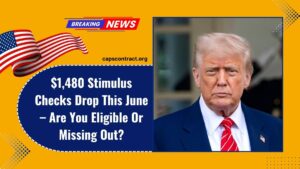As inflation and everyday costs remain burdensome for many Americans, the federal government has announced a $1,702 stimulus check to provide targeted relief in 2025.
This financial aid is part of an ongoing effort to help low- and middle-income households cope with rising costs related to housing, groceries, healthcare, and fuel.
Here’s everything you need to know about the $1,702 stimulus payment, including eligibility criteria, payment dates, and how to make sure you receive your money without delay.
Who Is Eligible for the $1,702 Stimulus Check in 2025?
The eligibility rules for this round of payments are similar to past stimulus programs, but with updated income caps and broader inclusion for dependents and non-filers.
Eligible Groups Include:
- Single filers earning up to $75,000
- Married couples filing jointly earning up to $150,000
- Heads of household earning up to $112,500
The payment phases out gradually for higher earners and ends completely beyond:
- $100,000 for single filers
- $200,000 for joint filers
- $140,000 for heads of household
Additional groups who may also qualify include:
- Social Security beneficiaries (SSA, SSDI, SSI)
- Veterans receiving VA benefits
- Non-filers with low or no taxable income
- Adult dependents and college students (may be eligible for partial payments)
When Will the $1,702 Stimulus Checks Be Sent?
The distribution of the stimulus checks is scheduled in two waves:
Wave 1 – August 2025
- For most taxpayers with 2023 or 2024 returns filed
- Payments sent via direct deposit or paper checks
Wave 2 – September to October 2025
- For Social Security recipients, VA beneficiaries, and non-filers
- Payments issued via SSA-linked accounts or mailed checks
Eligibility and Payment Schedule Overview
| Filing Status | Income for Full Payment | Phase-Out Limit | First Payment Date | Payment Method |
|---|---|---|---|---|
| Single | Up to $75,000 | $100,000 | August 2025 | Direct Deposit / Check |
| Married Filing Jointly | Up to $150,000 | $200,000 | August 2025 | Direct Deposit / Check |
| Head of Household | Up to $112,500 | $140,000 | August 2025 | Direct Deposit / Check |
| Social Security Recipients | Based on income | Based on SSA data | September 2025 | SSA-linked Deposit |
| Non-Filers (Low Income) | Must register via IRS tool | N/A | October 2025 | Paper Check / Debit Card |
How to Secure Your $1,702 Stimulus Payment
To ensure you receive your payment on time:
- File your 2023 and 2024 taxes if you haven’t already
- Update your direct deposit and mailing info with the IRS
- Social Security recipients should ensure their benefit status is current
- Non-filers must use the IRS Non-Filer tool once it goes live
The IRS “Get My Payment” portal will be reactivated for this round, allowing individuals to check status, update details, and confirm eligibility before funds are released.
Why the $1,702 Stimulus Check Matters in 2025
Economic pressures remain a concern for millions. Although job markets have stabilized, real wages haven’t kept up with the cost of essentials. The $1,702 relief payment is a targeted measure meant to ease financial burdens and help maintain basic household spending.
This one-time payment is not a universal income program, but a temporary safety net to help Americans manage daily expenses amid ongoing inflation.
FAQs
Do I need to apply for the $1,702 stimulus payment?
Most individuals do not need to apply. If you filed taxes for 2023 or 2024, or receive Social Security benefits, you’ll be processed automatically.
When will Social Security recipients get their payments?
Eligible Social Security recipients will begin receiving payments in September 2025, usually via direct deposit through SSA systems.
Can I get the stimulus check if I didn’t file taxes?
Yes, if you meet the income requirements. Use the IRS Non-Filer tool when it becomes available to register your details.




